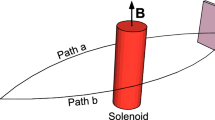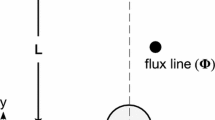Abstract
The classical electromagnetic lag associated with the Aharonov-Bohm phase shift can be obtained by using a Darwin-Lagrangian analysis similar to that given by Coleman and Van Vleck to identify the puzzling forces of the Shockley-James paradox. The classical forces cause changes in particle velocities and so produce a relative lag leading to the same phase shift as predicted by Aharonov and Bohm and observed in experiments. An experiment is proposed to test for this lag aspect implied by the classical analysis but not present in the currently-accepted quantum topological description of the phase shift.
Similar content being viewed by others
References
1. Y. Aharonov and D. Bohm, “Significance of electromagnetic potentials in quantum theory,” Phys. Rev. 115, 485–491 (1959).
2. See, e.g., D. J. Griffiths, Introduction to Quantum Mechanics (Prentice Hall, Upper Saddle River, New Jersey 1995), pp. 343–349, or J. J. Sakurai, Modern Quantum Mechanics, revised edn. (Addison-Wesley, Reading, MA, 1994), pp. 136–139, 472–473.
3. W. Ehrenberg and R. E. Siday, “The refractive index in electron optics and the principles of dynamics,” Proc. Phys. Soc. Lond. B 62, 8–21 (1949).
4. B. Liebowitz, “Significance of the Aharonov-Bohm effect,” Nuovo Cimento 38, 932–950 (1965); “Significance of the Aharonov-Bohm effect. Rebuttal of a criticism,” 46B, 125–127 (1966). T. H. Boyer, “Classical electromagnetic deflections and lag effects associated with quantum interference pattern shifts: Considerations related to the Aharonov-Bohm effect,” Phys. Rev. D 8, 1679–1693 (1973); “The Aharonov-Bohm effect as a classical electromagnetic-lag effect: An electrostatic analogue and possible experimental test,” Nuovo Cimento 100B, 685–701 (1987); “Semiclassical explanation of the Matteucci-Pozzi and Aharonov-Bohm phase shifts,” Found. Phys. 32, 41–49 (2002). The work by B. Liebowitz sees a need for new non-Lorentzian forces in order to explain the Aharonov-Bohm phase shift. My own work is entirely within the context of conventional classical electromagnetic theory.
5. G. Matteucci and G. Pozzi, “New diffraction experiment on the electrostatic Aharonov-Bohm effect,” Phys. Rev. Lett. 54, 2469–2470 (1985).
6. T. H. Boyer, “Darwin-Lagrangian analysis for the interaction of a point charge and a magnet: Considerations related to the controversy regarding the Aharonov-Bohm and Aharonov-Casher phases shifts,” J. Phys. A: Math. Gen. 39, 3455–3477 (2006).
7. S. Coleman and J. H. Van Vleck, “Origin of ‘hidden momentum forces’ on magnets,” Phys. Rev. 171, 1370–1375 (1968).
8. W. Shockley and R. P. James, “‘Try simplest cases’ discovery of ‘hidden momentum’ forces on ‘magnetic currents’,” Phys. Rev. Lett. 18, 876–879 (1967).
9. T. H. Boyer, “Classical electromagnetic interaction of a charged particle with a constant-current solenoid,” Phys. Rev. D 8, 1667–1679 (1973).
10. R. G. Chambers, “Shift of an electron interference pattern by enclosed magnetic flux,” Phys. Rev. Lett. 5, 3–5 (1960), first observed the phase shift. M. Peshkin and A. Tonomura, The Aharonov-Bohm Effect (Lecture Notes in Physics, Vol. 340) (Springer, New York, 1989), give extensive references to the experimental tests.
11. T. H. Boyer, “Misinterpretation of the Aharonov-Bohm effect,” Am. J. Phys. 40, 56–59 (1972). R. J. Cook, H. Fearn, and P. W. Milonni, “Fizeau's experiment and the Aharonov-Bohm effect,” Am. J. Phys. 63, 705–710 (1995). These articles point out that the from taken by the phase shift is sometimes presented incorrectly as, for example, in The Feynman Lectures on Physics, Vol. II (Addison-Wesley, Reading, MA, 1964), Sec. 15-5y.
12. See G. Matteucci and G. Pozzi, “New diffraction experiment on the electrostatic Aharonov-Bohm effect,” Phys. Rev. Lett. 54, 2469–2470 (1985), and T. H. Boyer, “Semiclassical explanation of the Matteucci-Pozzi and Aharonov-Bohm phase shifts,” Found. Phys. 32, 41–49 (2002).
Author information
Authors and Affiliations
Rights and permissions
About this article
Cite this article
Boyer, T. Proposed Experimental Test for the Paradoxical Forces Associated with the Aharonov-Bohm Phase Shift. Found Phys Lett 19, 491–498 (2006). https://doi.org/10.1007/s10702-006-0907-7
Received:
Revised:
Published:
Issue Date:
DOI: https://doi.org/10.1007/s10702-006-0907-7




